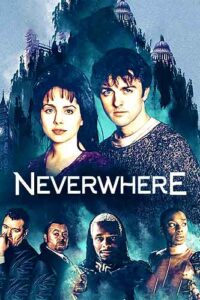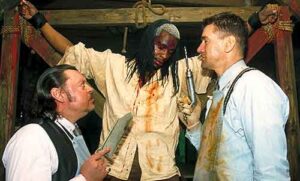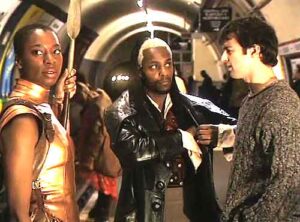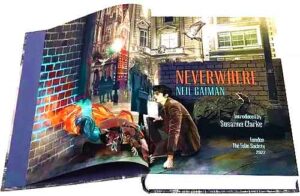NEVERWHERE was a BBC miniseries, originally broadcast in the Fall of ‘96. It was notable primarily for its scripter, the legendary comic book scribe Neil Gaiman, who at the time was best known for writing the long running SANDMAN comic series.
Gaiman’s endlessly fertile imagination is well utilized in NEVERWHERE, which is nothing if not inventive. It was also fairly unprecedented for its time, a lavish (in conception at least) six part fantasy about a vast netherworld located under the streets of London that’s governed by magic. That concept may not seem too original now, but remember, the publication of the first HARRY POTTER book, which was quite NEVERWHERE-like, was still nearly a year in the future when the BBC show premiered on September 12, 1996. It was not an overwhelming success.
The fact that the series was so little seen in its native land has only enhanced its allure here in the US. BBC America didn’t yet exist in 1996, and television programs in general were pretty scant on home video. Unsurprisingly, VHS bootlegs of NEVERWHERE sold briskly at comic and horror conventions throughout the remainder of the nineties.
Quality-wise I’d like to say that NEVERWHERE was deserving of the sizeable cult it amassed, but that’s just not the case. While laudable in many respects, it suffers from a noticeably scant budget that failed to do Gaiman’s ambitions justice. It also has an ugly look (the Achilles’ heel of many a pre-2000 BBC production) that apparently came about due to the fact that the series was initially supposed to be shot on film, and lit accordingly, but wound up being lensed on low quality video. That aspect was forgivable back in ‘96 but not so much these days; as Gaiman himself has admitted, the image quality of the multi-generation VHS bootlegs of NEVERWHERE that proliferated during the nineties was actually preferable to the “pristine” visuals of the 2003 DVD release.
That’s a shame, really, as Gaiman’s scripting is quite able. He relates the epic account of Richard Mayhew (Gary Bakewell), a discontented businessman drawn into “London Below” by a mysterious enchantress named Door (Laura Fraser). She’s looking to discover the reasons for her parents’ murder, thus providing her, Richard, her eccentric companion the Marquis de Carabas and the spear-carrying female bodyguard Hunter with an appropriately mythic, Joseph Campbell-worthy quest. Pursuing them are a pair of scumbags named Croup and Vandemar, who play golf with live frogs and like to crucify their enemies. There’s also a pasty vampire woman named Lamia who sucks peoples’ life force out of their mouths, and the Angel Islington, who lords over the inhabitants of London Below–and whose true nature may not be as angelic as it seems.
Gaiman’s wondrous imaginings include a painting the protagonists walk into, a horrific right of passage–or “ordeal”–in which Richard’s sanity is tested via arguments with himself in various different guises, and a labyrinth housing a mythological beast. Yet the low budget continually undercuts Gaiman’s conceptions, from the ordeal sequence, which was supposed to (but didn’t) feature elaborate animated intercuts and a train-full of corpses, to the climax, with its barely-glimpsed “Great Beast of London” (a costumed cow, apparently).
In fairness, the filmmakers did succeed in conjuring up some impressive elements with their non-budget. Most striking is the hallucinatory animated introduction, accomplished by the famed artist/filmmaker Dave McKean, a frequent Gaiman collaborator, on a Macintosh computer. The practical locations, including the cramped underground tunnels where London’s mail was once routed, are another budgetary consideration that actually works to the series’ advantage (although the gaudy lighting makes everything look unreal).
In 1996 Gaiman published a novelization of NEVERWHERE that was released as a standalone hardcover. The novel was later adapted into a Vertigo comic book miniseries and a Robert Kauzalaric scripted stage production. A feature film script has also been written, and reportedly optioned by The Weinstein Company, but remains unproduced.
It makes sense that the novel has become so iconic, as it is, frankly, superior to the series that inspired it. The novel is so good, in fact, that it makes me wish Gaiman wrote more adult fantasy novels, as to date he’s really only written two: 2001’s AMERICAN GODS and ‘05’s ANASI BOYS. The majority of his attention, of course, has been devoted to children’s fiction, including the popular CORALINE and screenplays, including McKean’s MIRRORMASK and Robert Zemeckis’ BEOWULF.
Yet the NEVERWHERE novel, which represents Gaiman’s “preferred text,” incorporating all the concepts that didn’t make it into the series, confirms something I’ve long suspected: that Gaiman’s true gifts are in the realm of prose fiction (see his 1993 collection ANGELS AND VISITATIONS and the aforementioned CORALINE and AMERICAN GODS for confirmation). This is evident in the novel’s pitch-perfect interplay of whimsical humor and pathos, and also its descriptive power; the subway train full of dead people that went unrealized onscreen is brought to memorable life in these pages, and the “Great Beast of London” described here, unlike that of the series, is indeed great. The characterizations are also quite strong, with Richard, Door, Croup, Vandemar and Lamia all far more concretely fleshed out than they were in the series.
A NEVERWHERE sequel has been discussed but has yet to come to fruition, in either televised or textual form. There are certainly all manner of intriguing directions in which this material can be taken, but perhaps NEVERWHERE is best preserved in its two present forms, one of them good (if not great) and the other a good try.




